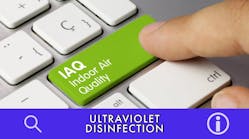DOE speakers put value on lighting for health (MAGAZINE)
From Feb. 1‒4, 2021, the US Department of Energy, in collaboration with the Illuminating Engineering Society, launched its virtual Lighting R&D Workshop to outline the state of research & development across the LED and solid-state lighting (SSL) sectors. A previously-published report outlined the march of LED and SSL technology through DOE programs and covered future innovation prospects on the DOE roadmap. We also recently published a blog that centered on workshop-presented data, analytics, and software and automation capabilities that can assist with meeting energy and design objectives.
This report on the four-day virtual event will summarize emerging applications topics that were addressed during the speaker sessions, especially those moving ahead with what Lighting R&D program manager Brian Walker described as “meeting the moment.” With the current state of the SSL industry, commercial opportunity as viewed through the DOE lens is driven not only by advancing the US toward prescribed energy goals but also more recent concerns that have shifted to making crucial connections between light and health. Some information may be reported here out of the order in which it was presented during the program for consistency of topic.
Setting the standard for GUV success
Standards — or lack thereof — were mainly the message of the moment with regard to germicidal ultraviolet (GUV) products and applications. In setting up session context for “Realizing the Potential of GUV: Perspectives from SSL Technology Development,” IES manager of government affairs and public policy Alex Baker nailed the disturbing reality of the pandemic-promoted flood of products to market. Baker noted that the direct-to-consumer approach for many disreputable products has already created negative outcomes for individuals, from having been exposed to unsafe levels of UV-C radiation to those having purchased devices without testing or certification backing manufacturers’ claims, and relying on a false sense of protection from pathogens such as the coronavirus SARS-CoV-2.
As with LED lifetime performance claims that Baker called out in an early 2020 feature article, he implored the lighting industry to work together and do its part to help prevent bad product experiences from setting a negative reputation for properly designed and verified disinfection technologies.
Baker also explained that the IES has partnered with the International Ultraviolet Association (IUVA) to pursue development of standards, which will yield measurement methodologies for UV LED and lamp sources that are targeted at disinfection. Note that these developments are intended to guide manufacturers and product developers with proper characterization data — not to deliver certification opportunities for consumer end products, which will come from other organizations.
Dave Sliney, chair of the IES Photobiological Committee, provided an update on, yes, photobiological standards that apply to GUV or UV germicidal irradiation (UVGI) applications and products. He said photobiological exposure references have two components — emission versus exposure — with regard to UV radiation-emitting lamps and lamp sources. Emission limits, sometimes known as “accessible emission limits,” are used in product safety standards from the IEC, UL, and others. They are measured based on pre-determined levels of UV to which people might be exposed. Exposure limits are used in occupational safety standards and measured at the location of an exposed individual, with a metering tool. The existing general standard is ANSI/IES RP27-20, “Recommended Practice for Photobiological Safety for Lamps and Lamp Systems,” offering general guidance going back to 1993. Currently, the IES is working on RP27-xx, “Recommended Practice: Ultraviolet Germicidal Irradiation (UVGI),” which will target safety standards for upper-room or whole-room UVGI. The first ballot was completed shortly before the end of December, and editorial comments are now being handled.
Cameron Miller of the National Institute of Standards and Technology (NIST) and Ruth Taylor of Pacific Northwest National Laboratory (PNNL) drilled down into the R&D needs for determining and achieving new target objectives in GUV technology and applications. Miller summarized the steps for measuring and evaluating UV-C disinfection sources as:
1. Characterize the UV source
2. Model the environment
3. Compare exposure limit/dose required
4. Verify implementation after installation
However, Miller astutely observed that as of right now, there is no consensus on radiometric dosage of UV-C due to the varying impacts of different pathogens. Although scientists generally understand and agree that UV-C radiation can damage the DNA of various pathogens, rendering them essentially inactive (Fig. 1), the action spectra and intensity of UV that deactivate a specific bacterium or virus might not do the same for another. Safe surrogate organisms to sample in biosafety labs, Miller concluded, would help immensely in moving toward consensus data that can be used for verification.
Taylor’s presentation was intended to open discussions on new technology focuses for the CALiPER program, which LEDs Magazine has frequently covered over the years. [See past reports on indoor SSL, outdoor area SSL, and tunable luminaires, for example.] Taylor recapped the initial environment in which the DOE launched CALiPER to provide high-quality and objective performance data in order to reduce market risk and subdue the “wild, wild West” approach to commercializing LEDs for general illumination. While Taylor did not recommend a specific approach to adapting CALiPER testing for GUV, she did point to the methodology and program as one way to minimize market risks, engage with standards developers, and improve quality and efficacy of products for UVGI applications on the commercial market.
A healthy dose of reality
Several aspects of quantifying the quality of the indoor environment were discussed during the Lighting R&D Workshop program. For the purposes of this report, we will focus on metrics, case studies, and findings related to lighting for health, specifically circadian-effective lighting and human-centric design that delivers visual comfort in the space. The nearby table summarizes 2019 reported DOE Lighting R&D opportunities for physiological impacts of light on humans, listing status, potential studies, and translation into best practices and commercial targets for implementation for context on the DOE program approach to adoption of lighting that affects human health.
During Day 1, PNNL’s Kelly Gordon moderated an “'Ask Me' Session” on bridging the essential concepts of light and health research and application. Speakers answered questions on circadian metrics and on what studies they are based, in particular why current metrics focus on melatonin suppression. Much of the earlier foundational research has been previously reported from LEDs Magazine’s Lighting for Health and Wellbeing Conferences in 2017 and 2018, with regard to long-term studies on the impact of light cycles, light spectra, and light levels on various aspects of human health beyond the visual level, so we won’t repeat that information here.
In addressing metric development that has been based on observing melatonin suppression, Stanford University’s Jamie Zeitzer, PhD, a circadian physiologist, alleged that today “we don’t really care about melatonin suppression” with regard to evolving metrics and bringing them to practice. He said more recent studies from 2018 through 2020 show how different intrinsically photosensitive retinal ganglion cell (ipRGC) sub-types elicit diverse reactions or influence functions of the human non-visual system. “You can give light that can have a robust phase-shifting effect and have almost no impact on melatonin, in terms of its acute suppression,” he said. Varying sequences of light spectra, flashes of high-brightness light, or intermittent monochromatic light exposures have been tested, and Zeitzer concluded, “They do indicate…there is likely to be an ability to separate out melatonin suppression from melatonin phase shifting.”
Why does this matter? According to Zeitzer, the data indicate that melatonin suppression requires sustained light exposure. When you remove the light stimulus, melatonin reverts quickly to normal levels, which is consistent with a strong involvement of the ipRGC melanopsin. The light levels that suppress melatonin will vary greatly among individuals, Zeitzer admitted, echoing earlier comments from Monash University speaker Andrew Phillips. “However, you can have phase shifting to light that is short, long, continuously changing in intensity,” which he claimed gives added weight to changing approaches and interpretations for metrics to view phase shifting as involving melanopsin plus cones in the eye’s receptors. This may allow development of studies that take into consideration the temporal nature of the light to which humans are exposed every day and measure responses to deliver better circadian lighting metrics. Zeitzer noted that scientists should now question “‘Do we need to use a model that really combines cones plus that of melanopsin?’ and that’s something that we really don’t have at this point.” He concluded that there is plenty more to accomplish with data collection and verification.
During the live Q&A after the session, Zeitzer and speaker Erin Flynn-Evans, a NASA scientist, asserted that improved wearables and devices for logging activity and measuring light as it comes into the eye will play a significant role in defining strategies for circadian lighting and personalized adaptive lighting – with, of course, the proper funding.
Turning to the reality of current application studies, on Day 2 Harvard Medical School researcher Shadab Rahman, PhD, spoke to the audience about lighting in the healthcare environment, looking beyond the conceptual circadian effectiveness of light to the functionality of the light for visual tasks, comfort, and safety in both direct patient care and in long-term care facilities. In daily life, many people are discomfited by applying mathematical values to human lives, patient care costs, and facilities management, but Rahman noted that statistics can put perspective on improvements in the clinical and care facility environment that administrators can understand in terms of cost.
Rahman presented data on evaluating the practical impact of lighting in several institutional instances from various healthcare stakeholders — at the care recipient, care provider, and institution levels. For example, he stated that about 1 in 3 elderly adults (aged 65 and older) fall annually, leading to physical injuries and loss of mobility, as well as loss of independence. In 2015, he reported, the estimated medical costs attributable to both fatal and non-fatal falls was about $50 billion according Florence et al. in the Journal of the American Geriatrics Society (2018). That’s a significant burden on US Medicare, Medicaid, and other payers, he noted. So a team of researchers designed a study to determine whether lighting intervention in long-term care facilities could help to reduce falls (Fig. 2).
Studies were planned for intervention (two sites) and control (two sites) across four facilities in total for 12 months before lighting modification and 12 months post-intervention. At the intervention sites, commercially-available fixtures provided a dynamic lighting schedule across general gathering areas, staff workstations, and bedroom zones. During the day in the common areas and bedrooms, lighting was provided at 6500K CCT and higher brightness levels, whereas at night the light became dimmer and warmer to 2700K. The nursing station featured blue-enriched light both day and night for staff alertness. A total of 723 residents involved resulted in 60,268 occupied resident-days during the study period. After the collection period, the data showed a total of 855 falls recorded in the two years across the four facilities. Per 1000 resident-days, pre-intervention fall rates at both the intervention and control sites was calculated to 7.4 falls. Post-intervention, the intervention sites showed a reduction to 5.0 falls per 1000 resident-days, while the control sites rate increased to 8.4 falls.
The changes in lighting equipment resulted in a 40% decrease in resident falls and therefore the outcome was reduced care costs associated with such incidents. Similar impact studies can help administrators see the value in applying a metric approach to cost and safety considerations across many types of healthcare facilities. Rahman also delved into a study on lighting impact on medical errors, which we won’t recount here. During the session Q&A, Rahman commented that standardized definitions in lighting for health and wellbeing and human-centric lighting are sorely needed — even circadian lighting does not have a consensus definition, he said — to bring further clarity to study design, lighting design objectives, and applied metrics.
Although not a participant during this workshop, lighting scientist Allison Thayer, who is now with the Mount Sinai Light and Health Research Center at Mount Sinai Icahn School of Medicine (formerly of the Lighting Research Center at Rensselaer Polytechnic Institute), has written a multi-part series for LEDs Magazine on circadian lighting terminology and metrics used to characterize circadian-effective light. It remains to be seen how these concepts will take hold in the lighting market, but we look forward to stakeholders’ response and input on this series.
This is by no means a full synopsis of the DOE workshop program, merely a summary of timely and compelling developments that may assist in propelling commercialization of lighting for health and wellbeing. Registered Lighting R&D Workshop attendees can still access the full presentations and resources on demand at https://bit.ly/37fjaeA.

Carrie Meadows | Editor-in-Chief, LEDs Magazine
Carrie Meadows has more than 20 years of experience in the publishing and media industry. She worked with the PennWell Technology Group for more than 17 years, having been part of the editorial staff at Solid State Technology, Microlithography World, Lightwave, Portable Design, CleanRooms, Laser Focus World, and Vision Systems Design before the group was acquired by current parent company Endeavor Business Media.
Meadows has received finalist recognition for LEDs Magazine in the FOLIO Eddie Awards, and has volunteered as a judge on several B2B editorial awards committees. She received a BA in English literature from Saint Anselm College, and earned thesis honors in the college's Geisel Library. Without the patience to sit down and write a book of her own, she has gladly undertaken the role of editor for the writings of friends and family.
Meadows enjoys living in the beautiful but sometimes unpredictable four seasons of the New England region, volunteering with an animal shelter, reading (of course), and walking with friends and extended "dog family" in her spare time.




![The DesignLights Consortium continues to make progress in shifting outdoor lighting products and implementation practices toward a more restrained and thoughtful strategy. [Image does not represent a DLC qualified fixture.] The DesignLights Consortium continues to make progress in shifting outdoor lighting products and implementation practices toward a more restrained and thoughtful strategy. [Image does not represent a DLC qualified fixture.]](https://img.ledsmagazine.com/files/base/ebm/leds/image/2024/08/66be810888ae93f656446f61-dreamstime_m_265700653.png?auto=format,compress&fit=&q=45&h=139&height=139&w=250&width=250)


